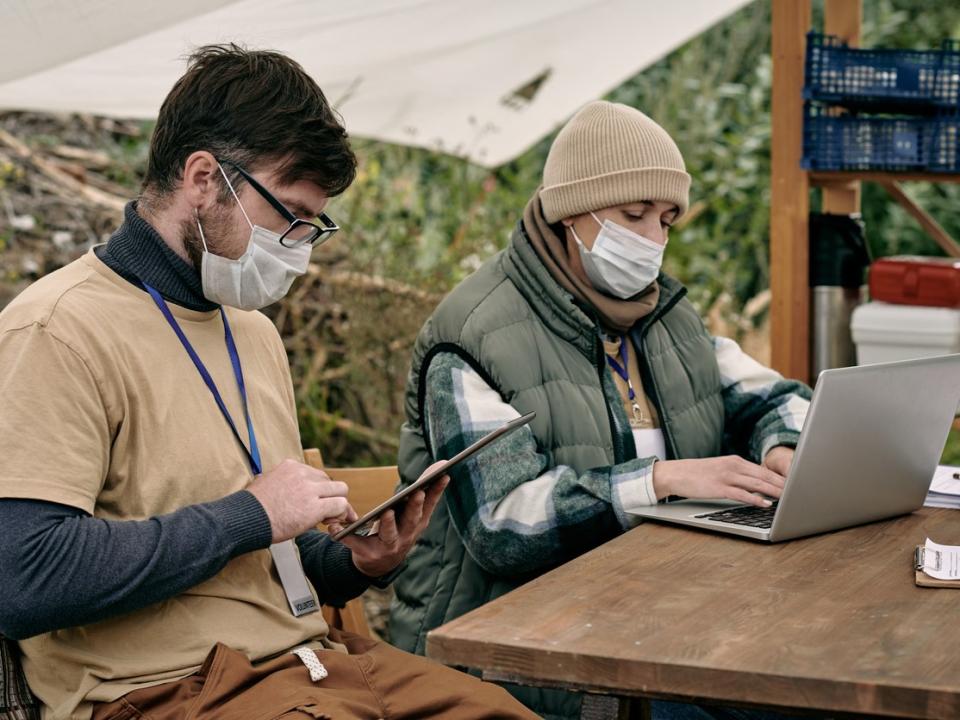In May, for the first time ever, the world hit a harrowing record of 100 million people forcibly displaced around the world. At least 30 million of those displaced are refugees, a majority of whom experience protracted displacement, residing in a country of asylum for five years or longer.
With generations of youth having spent their entire lives in refugee communities, education is often heralded as the optimal route for youth seeking pathways to economic independence. However, myriad barriers such as infrastructure limitations, restriction of movement and/or education, and large opportunity costs exist for refugee learners, resulting in only 5 per cent of refugees participating in higher education.
- Increasing access to higher education for refugees through digital learning
- Helping refugees get their qualifications recognised
- ‘Making it’ in the US: education and employment for Afghan refugees
As models of high-quality online and digital learning evolve around the globe, colleges and universities should be asking themselves how they can leverage lessons learned during the pandemic to further extend access to hard-to-reach populations such as refugees in camps, settlements and urban areas around the world.
Below are a few critical reflections for higher education institutions (HEIs) to bear in mind when developing digital resources for refugee learners.
Take stock of university capacity and leverage institutional strengths
Are there existing digital assets at your university that require little to no content revision, are contextually relevant and can be quickly delivered with a new learner population? If so, consider piloting these assets with the target population and use what you learn to iterate on the existing course and inform new curricular developments. Note that not all content can be repurposed for a new population – there are language and cultural specificities to consider – but you may find that there are existing courses that require minimal tweaking and thus can be prioritised.
Consult stakeholders
Maintain regular dialogue with learners, partners and peers to identify existing gaps and opportunities in the provision of higher education for refugees. Travel to programme areas to better understand the conditions in which your courses are being delivered. Face-to-face conversations with partners build trust, while speaking directly to learners gives a first-hand account of their goals and interests. By asking learners about their long-term goals, your programme team can design course sequences and pathways that facilitate those goals.
Engage in conversations with peer institutions regularly to 1) stay abreast of important developments in the field of higher education for refugees; 2) share lessons learned; and 3) collaborate to enhance the number and quality of higher education opportunities. This United Nations High Commissioner for Refugees (UNHCR) website maintains a database of current university scholarships and programmes for refugees, updated regularly as new opportunities emerge. The Connected Learning in Crisis Consortium (CLCC) website is another resource for practitioners with clear guidelines for providing high-quality blended/connected HE programmes for refugees around the world.
After consulting stakeholders, you should be able to answer the following questions: 1) What do learners want? 2) Are potential courses relevant to the context and local workforce? 3) What skills and credentials will students have after completing the course of study? 4) What are the next steps for students after completion of the course or pathway?
Integrate technology appropriately
Ensure that you have a good grasp of the technical specifications of your digital assets and whether they are compatible with the technical capacity of your partner organisations and future students. This means knowing how learners will engage the digital or online material – will learners be travelling to computer labs to take classes? What are the specifications of the computers in that lab? Is software up to date, enabling your online content to run seamlessly? Is the internet able to accommodate the type of digital assets you have incorporated into the courses? Are there third-party integrations that might fail if a certain bandwidth threshold is not met?
The answers to these questions have a colossal impact on digital course design. If there is a shortage of laptops or computers, consider the impact of device-sharing on student performance. You might embed cheating safeguards into the course design, for example. If most of your learners are using a mobile device to access content, instructional designers might incorporate more interactive knowledge checks rather than writing assignments. In this way, the delivery of content complements the mode of learning.
Cultivate a continuous feedback loop
Provide ways for learners to share honest feedback on the digital resource. Most learning management systems (LMSs) offer multiple ways to facilitate this feedback. Consider building pre-course surveys that capture student expectations, motivation and confidence levels as they embark on a learning journey through your course. Post-course surveys can collect specific feedback on the design, execution, strengths and weaknesses of the digital content, and whether students’ expectations were met. This is also an opportunity to capture suggestions that would improve the overall course experience and contextual relevance of content to various student populations. Provide systems for gathering feedback from other relevant collaborators as well.
Partner with other universities or organisations to fill content gaps
While higher education for refugees takes many forms and is pursued for myriad reasons, the majority of digital higher education opportunities currently available to refugee youth are short courses or individual courses that do not necessarily culminate in a university degree. While a certificate, badge or other credential can confer immediate benefits to the student, particularly among employers, digital higher education resources should be created with an eye towards awarding degrees.
It can be challenging for any one university to accommodate the design and delivery of a degree pathway bespoke for refugees, therefore it may behove higher education institutions serving refugees to architect new degree pathways more quickly by combining the digital assets of several universities in a sequence that satisfies accreditation requirements in a given field. A strong programme might be modular and stackable – with students advancing skills and learning new competencies with every course completion, and the possibility of earning a degree should the academic requirements be fulfilled.
Cross-sector collaboration is key
Underpinning this set of recommendations is the humble acknowledgement that, despite universities having an abundance of technical capacity and expertise, the extension of these tools in refugee-hosting settings requires a nuanced approach. In learning from and leaning on the multitude of cross-sectoral actors in this space, each university has a valuable role to play in our common goal of helping refugee students reach their educational ambitions.
Nicholas Sabato is senior director and Joanna Zimmerman is associate director, Education for Humanity at Arizona State University.
If you found this interesting and want advice and insight from academics and university staff delivered direct to your inbox each week, sign up for the THE Campus newsletter.




comment